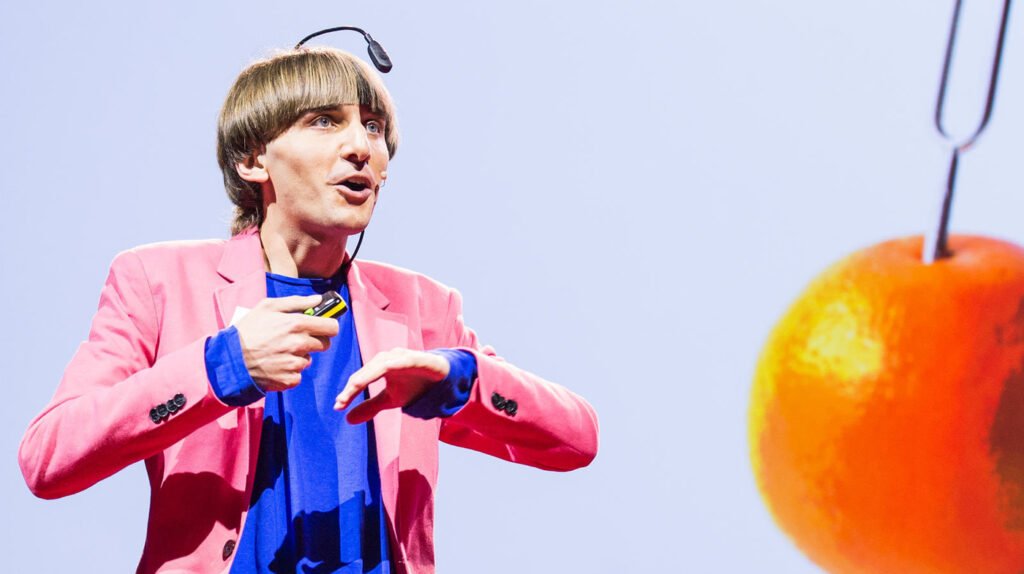For the past two decades, Neil Harbisson, a self-described “cyborg artist,” has sparked debate with a radical technological enhancement: an antenna surgically implanted into his skull. Harbisson, who grew up in Barcelona, was born with achromatopsia, a rare condition that affects one in 33,000 people, leaving him unable to see any color, only shades of grey.
In 2004, Harbisson underwent surgery to attach the antenna, which fundamentally changed his life. The device, embedded at the back of his head, transforms light waves into sound frequencies, allowing him to “hear” colors. Harbisson’s decision to modify his body wasn’t about restoring a lost sense but about enhancing his perception beyond human limitations. His transformation into a cyborg—a being with both human and machine elements—has made him the subject of fascination and controversy alike.
Filmmaker Carey Born was “astonished” when she first encountered Harbisson and soon decided to document his life. The result is Cyborg: A Documentary, which explores how Harbisson navigates life post-augmentation, along with the effects of this groundbreaking surgery. “The reason he did it wasn’t to replace a sense he lacked—it was to create an enhancement,” Born explains. This, she says, was the driving hook of her film.
Before becoming a cyborg, Harbisson had experimented with technology to perceive color. With the help of Plymouth University cybernetics expert Adam Montandon, he began using a system of headphones, a webcam, and a laptop to transform colors into sounds. However, Harbisson wanted a more intimate integration of this technology with his body. After several refusals from Spain’s bioethical committees, he finally found anonymous doctors willing to operate, inserting the antenna directly into his skull, where bone later grew over the implant.
Harbisson explains that he doesn’t feel like he uses technology; instead, he says, “I feel like I am technology.” His antenna is equipped with a chip that transmits color sounds directly through the bone in his skull and can connect to the internet and nearby devices. This self-described “cyborg” now lives in a constant state of augmented perception, interacting with reality in ways most humans can’t imagine.
However, his post-surgery journey hasn’t been without its difficulties. Initially, Harbisson experienced five weeks of intense headaches, and it took several months to fully adapt to the new sensory input. He even struggled with depression, which filmmaker Born compares to the side effects experienced by those undergoing trepanning—an old practice of drilling holes into the skull.
Beyond the physical challenges, Harbisson has faced serious social backlash. His body modification has led to death threats from people who see his work as “anti-natural” or “anti-God.” This hostility eventually forced him and his partner, fellow cyborg Moon Ribas, to relocate to an undisclosed location. Ribas, also featured in the film, praises Harbisson’s courage, stating, “He likes to do things differently.”
Despite these hurdles, Harbisson’s credo remains strong: “Design Yourself.” Through his not-for-profit Cyborg Foundation, he aims to make augmentation accessible to as many people as possible, arguing that we’re already giving machines additional senses—so why not extend our own? However, this raises ethical concerns, as Born and others point out in the film.
The film also questions the security risks of body augmentation. Born worries about the potential for hacking, particularly if these technologies are developed or controlled by elite organizations. This concern is echoed by scientists like Dani Clode, a designer from Cambridge University’s neuroscience lab, who is experimenting with augmentation devices like a third thumb or a tentacle arm. Clode stresses the importance of studying how these enhancements affect the brain, as initial findings suggest that even short-term use of such devices can fundamentally alter neural pathways.
The larger debate surrounding cybernetic technology—how it should be regulated and who should have access—has grown increasingly relevant as technology accelerates faster than regulatory bodies can keep up. Born’s documentary ultimately calls for a cautious approach, raising questions about who will control the future of human augmentation and whether society is prepared for its consequences.
As Harbisson continues to push the boundaries of what it means to be human, his work forces us to confront an emerging reality: the fusion of biology and technology is no longer a matter of science fiction, but of everyday life. Whether we see this as an exciting opportunity or a cause for concern, one thing is clear—cybernetics is already here, and it’s changing what it means to be human.
Also read: Ulster Orchestra Revives Townsend Street With Musical Memories
